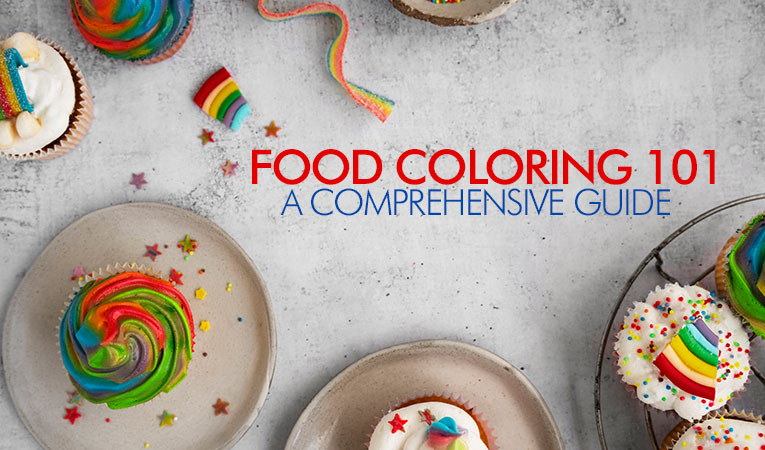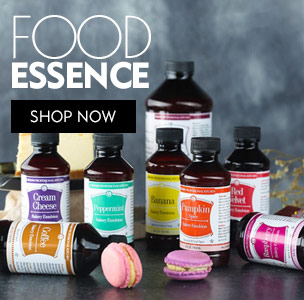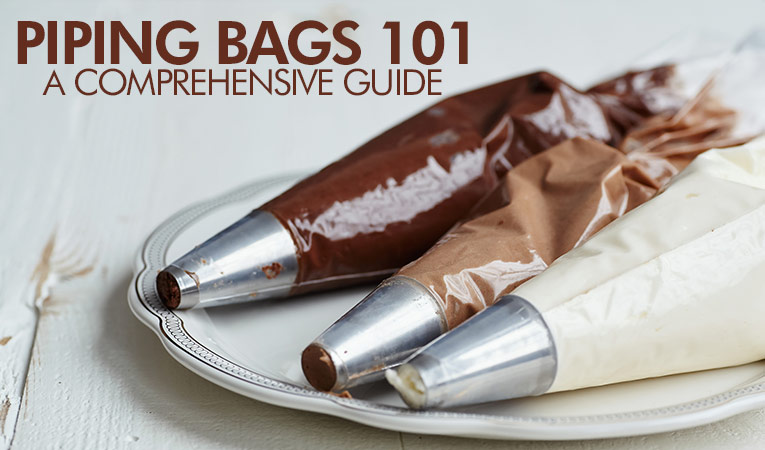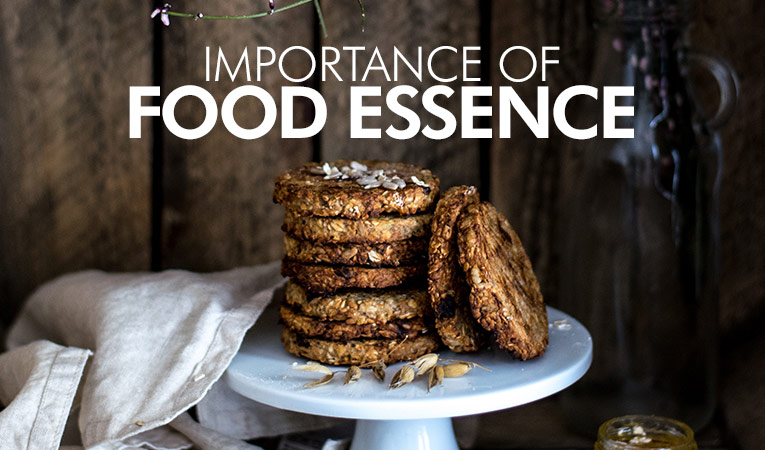Food Coloring 101: A Comprehensive Guide
11-09-2023

In the world of baking, every masterpiece begins with a dash of inspiration and a burst of color. Food coloring, a ubiquitous yet often underestimated ingredient, plays a pivotal role in turning the ordinary into the extraordinary. As the apron-clad artists of the kitchen, bakers understand the enchanting power of food coloring to elevate their creations to a whole new level of visual delight.
Welcome to a delectable journey into the realm of food coloring, a world where shades and hues are as essential as flour and sugar. In this comprehensive guide, we'll unravel the art and science of food coloring, exploring its myriad applications in the baking universe.
Food coloring isn't just about making cakes look pretty; it's about telling stories through vibrant layers of fondant, celebrating occasions with colorful cookies, and sparking joy with rainbow-hued macarons. But beyond its dazzling appearances, food colors holds secrets: the diverse types, the chemistry behind their transformation in the oven's heat, and the paramount importance of using them safely.
Throughout the sections that follow, we'll delve into the spectrum of food color possibilities, from natural pigments inspired by nature to the synthetic wonders born in the laboratory. We'll uncover the science behind these mesmerizing transformations and provide insights into responsible and creative usage.
Whether you're a seasoned pastry chef or an adventurous home baker, this guide will equip you with the knowledge to paint your edible dreams with precision and flair. So, roll up your sleeves, preheat the oven, and prepare to embark on a vibrant and flavorful journey into the world of food colors in baking.
Types of Food Coloring
When it comes to adding that captivating burst of color to your baked creations, the world of food coloring offers a wide palette of options. These colorful additives can be broadly categorized into two main types: natural and synthetic.
- Natural Food Colors: Derived from nature's own vibrant sources, natural food coloring is a boon for bakers looking to infuse their treats with hues straight from the earth. Fruits and vegetables, with their rich pigments, are often the stars of the natural food color show. Think of the luscious reds from beets, the sunny yellows from turmeric, or the deep purples from blueberries. These natural sources not only impart captivating colors but also bring their unique flavors and nutritional benefits to the table.
- Synthetic Food Colors: Synthetic or artificial food colors, on the other hand, are the result of careful chemical formulations in the lab. These colors are prized for their consistency and intensity, making them a staple in the bakery industry. You'll find synthetic food colors in everything from vibrant sprinkles atop cupcakes to the uniform shades of mass-produced candies. They offer precision in coloration, ensuring your baked goods look as good as they taste.
- Regulatory Oversight: In India, the Food Safety and Standards Authority of India (FSSAI) plays a crucial role in regulating the use of food coloring. Their guidelines ensure that food colors meet safety standards and are appropriately labeled. This oversight is essential for both bakers and consumers, guaranteeing that the colors used are safe for consumption.
As you embark on your colorful baking journey, consider the nuances of each type of food coloring. Natural colors provide a wholesome, farm-to-table appeal, while synthetic colors offer precision and consistency. By understanding the options and adhering to regulatory guidelines, you can wield the art of food coloring with confidence and creativity in your baking endeavors.
The Science of Food Coloring
Food coloring might seem like magic, but its vibrant transformations are all about chemistry at the molecular level. To understand how these colors work, let's delve into the fascinating science behind them.
- Molecular Magic: At the heart of food coloring are tiny molecules that absorb and reflect light. These molecules give objects their color by absorbing certain wavelengths of light and bouncing others back to our eyes. The specific color we perceive depends on which wavelengths are absorbed and which are reflected.
- pH Power: The pH level of a food item can significantly impact the stability and appearance of its color. Some food colors are sensitive to changes in pH, shifting their hues as acidity or alkalinity varies. For instance, red cabbage juice can transition from red in an acidic environment to blue in an alkaline one. This pH-dependent color change can be harnessed creatively in baking and cooking.
- Different Strokes: Food colors come in various forms, each tailored to specific culinary needs. Water-based colors are versatile and mix easily into liquids. Oil-based colors, as the name suggests, are perfect for coloring fats like buttercream. Gel-based colors are highly concentrated and ideal for achieving deep, rich hues. Powder food coloring offers a different kind of versatility, suitable for dusting or dry blending. Understanding these distinctions helps bakers and chefs choose the right type of coloring for their recipes, ensuring the desired effect is achieved.
By appreciating the molecular magic, pH dance, and diverse forms of food coloring, you'll be better equipped to harness the art and science of these colorful additives in your culinary creations.
Food Coloring in Baking
In the world of baking, food coloring is a versatile and essential tool that not only adds a burst of color but also allows bakers to transform their creations into edible works of art. From vibrant cakes that mimic the colors of a sunset to artisanal chocolates that look like they belong in an upscale boutique, food color plays a pivotal role in achieving both visual appeal and thematic resonance in baked goods.
- Creating Edible Art: Imagine a child's delight when they bite into a cookie that matches the bright blue of the sky or the rich green of a lush forest. Or the awe of guests as they admire a multi-layered cake, each tier a different shade of a rainbow. Food colors allows bakers to infuse their creations with personality and theme, making every bite an experience beyond taste.
- Importance of Precision:In the world of baking, precision is paramount, especially when it comes to achieving the desired color. Whether it's a pastel macaron or a deep red velvet cupcake, the right hue can elevate the entire aesthetic of a dessert. A shade too light, and your masterpiece might lose its intended impact. Too dark, and it might not align with your vision.
- Tips for Perfect Color: To ensure the color intensity you desire, remember a few key tips. Start with a small amount of food color, as you can always add more if needed. Mix the coloring into your recipe slowly and thoroughly to avoid uneven distribution. Gel-based food colors are highly concentrated, so use them sparingly to avoid over-saturation. And remember that the color may deepen as your baked goods cool, so don't be alarmed if the final result is slightly darker than expected.
Food color is not just a tool for bakers; it's a passport to a world of creativity. With the right knowledge and techniques, you can turn your baking into a canvas, where every shade tells a story and every bite is a masterpiece. So, don your apron, pick up your food coloring, and let your imagination run wild in the kitchen.
Natural vs. Synthetic Food Coloring
When it comes to food coloring, there are two primary categories: natural and synthetic. Each type offers its own set of benefits and drawbacks, making the choice between them a critical consideration for food manufacturers, chefs, and consumers alike.
Here's a comparison between natural and synthetic food colors based on various points:
| Points | Natural Food Colors | Synthetic Food Colors |
|---|---|---|
| Source | Derived from natural sources like fruits, vegetables, and spices. | Often derived from synthetic or petroleum-based chemicals. |
| Allergic Reactions | Less likely to cause allergic reactions or sensitivities. | Some synthetic colors may be associated with allergic reactions. |
| Cost | Extraction of natural colors can be more labor-intensive and costly. | Typically more cost-effective, making them preferable for mass production. |
| Type | Obtained from natural ingredients, aligning with clean label preferences. | Often produced through chemical synthesis, raising concerns about their origin. |
| Applications | Offer subtle, nuanced flavors that can complement the taste of dishes. | Known for stability and a wider spectrum of colors, ideal for vivid or unique shades. |
| Shades | Natural colors have a limited color range. | Synthetic colors provide a broader range of vivid hues. |
| Durability | Susceptible to fading when exposed to heat, light, or oxygen. | Generally more stable and resistant to fading. |
| Color Pigmentation | Variability in color intensity due to factors like crop quality. | Easier to standardize and control for consistent color intensity. |
| Extraction Cost | Extraction of natural colors can increase overall production costs. | Regulatory scrutiny and stricter guidelines may apply to certain synthetic colors. |
These points highlight the key differences between natural and synthetic food colors, including their source, potential for allergic reactions, cost considerations, types, applications, and drawbacks. The choice between these two types of food colors ultimately depends on the specific needs and goals of food manufacturers and the preferences of consumers seeking natural or vibrant color options.
Food Coloring in Artistic Cuisine
Food coloring isn't just a kitchen staple; it's a vibrant palette for culinary artists to transform ordinary dishes into edible works of art. In the world of artistic cuisine, food coloring plays a pivotal role, allowing chefs and home cooks alike to unleash their creativity and turn everyday meals into visually stunning creations. Here's a glimpse into the artistic side of food coloring, along with inspiring examples that will surely ignite your culinary imagination:
- Decorative Pastries: Pastry chefs use food coloring to craft intricate designs on cookies, cakes, and pastries. From delicate floral motifs to whimsical patterns, these edible creations are as visually pleasing as they are delicious.
- Sugar Art: Sugar becomes a sculptor's medium with the help of food coloring. Talented artists mold and shape sugar into intricate flowers, lacework, and figurines, using a spectrum of colors to bring their creations to life.
- Edible Painting: Edible paints, made with food coloring, enable chefs to paint directly onto desserts. From detailed landscapes on chocolate canvases to abstract designs on fondant, the possibilities are endless, turning desserts into canvases.
- Interactive Culinary Art: Some restaurants offer interactive dessert experiences where diners can become artists. Food coloring is provided, allowing patrons to decorate their own desserts, turning the dining experience into a participatory art form.
Encouraging you to get creative in the kitchen, food coloring is your ticket to culinary artistry. So, the next time you cook or bake, think beyond taste and consider the visual feast you can create with the stroke of a brush or the swirl of a vibrant hue. Your kitchen is your canvas, and food coloring is your palette – let your culinary imagination run wild!
Food Coloring Safety and Regulations
Food coloring is widely used to enhance the visual appeal of foods, but it's essential to consider safety aspects, potential side effects, and regulatory oversight to ensure responsible consumption:
- Safety Considerations:
- Allergies: Some individuals may be allergic to specific food dyes, leading to adverse reactions like hives or gastrointestinal issues.
- Hyperactivity: Some studies suggest a link between certain food dyes and increased hyperactivity in children, although the evidence is inconclusive.
- Overconsumption: Excessive use of food coloring may lead to health concerns, such as digestive discomfort.
- Regulatory Oversight:
- FSSAI (Food Safety and Standards Authority of India) and other similar agencies in different countries establish regulations and guidelines for the safe use of food coloring.
- These agencies evaluate the safety and suitability of food color additives before allowing them in the market.
- They also set maximum permissible levels (MPLs) for food color additives in various food products to prevent overuse.
- Responsible Consumption:
- Check Labels: Always read food labels to identify the presence of food coloring, especially if you have allergies or sensitivities.
- Moderation: Consume foods with added food coloring in moderation to reduce the risk of adverse effects.
- Natural Alternatives: Explore natural food color sources, such as beetroot for red, spinach for green, and turmeric for yellow, to reduce reliance on artificial additives.
- Homemade Options: Consider making your own food coloring using natural ingredients like fruit juices or vegetable extracts.
While food coloring is generally considered safe when used within regulatory limits, it's crucial to be aware of potential side effects and consume these additives responsibly. Regulatory bodies like FSSAI play a vital role in ensuring the safety of food color additives, but individuals should also exercise caution and make informed choices about their consumption.
Conclusion
In conclusion, we've embarked on a colorful journey into the world of food coloring, exploring its multifaceted role in culinary artistry. Throughout this guide, we've learned that food coloring isn't just a kitchen tool; it's a medium through which chefs and home cooks alike can unleash their creativity and transform ordinary dishes into edible works of art.
As we navigate this realm of vibrant possibilities, it's crucial to keep safety in mind. Understanding potential side effects and allergies associated with food coloring, as well as practicing moderation, ensures that our culinary adventures remain enjoyable and health-conscious.
Regulatory bodies, such as the FSSAI, play a pivotal role in overseeing the safe use of food coloring, setting limits to safeguard our well-being. Their guidance helps us navigate this world of color with confidence.
Above all, we encourage you to embrace your inner artist and experiment with food coloring in your culinary creations. Whether you're a seasoned chef or a curious home cook, the palette of colors in your kitchen can elevate your dishes to new artistic heights. So, as you dive into the world of food coloring, consider the health and artistic possibilities it brings to your table, and savor the joy of creating beautiful and delectable masterpieces. Happy cooking!





